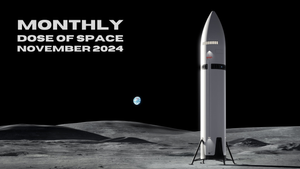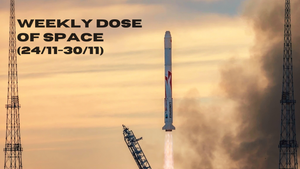
Weekly Dose of Space (4/8-10/8)
Welcome back to Weekly Dose of Space! This week had four launches occur worldwide, with one launch starting work on a new mega-constellation. News this week had Rocket Lab fire up a new engine, and NASA weighing its options for Starliner's crew. As always, we'll also look ahead to what the worldwide launch schedule might look like next week.
SpaceX
This week at Starbase started on August 4th when the CC 8800-1 crane used for stacking the second launch tower was lowered, ahead of extending it for stacking the final modules of the tower. The second launch tower is also six modules tall currently with the crane barely taller than it.
The following day, August 5th, workers were spotted removing thermal protection tiles from Ship 31's nose, beginning the replacement of its tiles like Ship 30. Early the next morning, August 6th, Ship 30 was once again rolled out to Massey's for testing, as the vehicle had one of its engines swapped out.
August 7th had the B14.1 test tank rolled back out to the launch site, possibly ahead of more catch testing using the towers 'chopsticks'. These tests would have the test tank sit on the orbital launch mount while the 'chopsticks' move around it. B14.1 was lifted onto the orbital launch mount later the same day.
Ship 30 performed a spin prime test with an unknown number of engines late on August 7th, most likely to test the replaced engine. August 9th would have Ship 30 return to the production site from Massey's.
Launches This Week
August 4th - Falcon 9 with Starlink Group 11-1
A Falcon 9 lifted off from Space Launch Complex 4E, in California, carrying twenty-three Starlink satellites to low Earth orbit. The booster for this mission was B1082 making its sixth flight, and landing downrange on the drone ship 'Of Course I Still Love You'.

August 4th - Falcon 9 with Cygnus NG-21
Also on August 4th, a Falcon 9 launched from Space Launch Complex 40, in Florida, carrying Northrop Grumman's twentieth Cygnus resupply mission to the International Space Station. The booster for this mission was B1080 flying for the tenth time and landing back at Landing Zone 1.

August 6th - Long March 6A with Qianfan Polar Group 01
A Long March 6A lifted off from the Taiyuan Satellite Launch Center carrying the first 18 satellites for China's Qianfan constellation. These satellites are believed to have been deployed at an altitude of approximately 800 kilometers. Details about this constellation are available here.

August 10th - Falcon 9 with Starlink Group 8-3
Another Falcon 9 launched carrying twenty-one Starlink satellites to low Earth orbit, this time from Space Launch Complex 40. The booster for this mission was B1067 for its twenty-first time and landing on the drone ship 'Just Read The Instructions' downrange.

In Other Space News
Archimedes breathes fire!

Rocket Lab announced on August 8th that it fired its liquid methane and liquid oxygen burning Archimedes engine! According to Rocket Lab, the firing had Archimedes running at 102% of its maximum thrust. Speaking to Business Wire, Peter Beck, Rocket Lab's Chief Executive Officer, said the following about the firing:
“Hot firing Archimedes is a major development milestone for Neutron and our team has done it on an accelerated timeline. Taking a new staged combustion liquid rocket engine from cleansheet design to hot fire in just a couple of years is industry-leading stuff." – "From the day we started designing Archimedes we focused on delivering a flight engine, rather than an early-stage prototype destined for multiple reworks and adjustments, so it's gratifying to see this strategy bear fruit.”
Ten Archimedes engines will power Rocket Lab's in-development partially reusable Neutron launch vehicle, with nine sea-level optimized engines on the first-stage and one vacuum-optimized engine powering the second-stage. Neutron's debut flight is currently expected to occur in 2025.
Starliner crew may return on Crew Dragon

NASA is currently evaluating issues on the Starliner spacecraft docked to the International Space Station for the Crew Flight Test mission. In a press briefing on August 7th, NASA said they expect to decide if the crew of Starliner's human-carrying mission will return with the spacecraft or on an alternative vehicle.
Since launch on June 5th, 2024, Starliner has been experiencing thruster failures and helium leaks. Multiple thrusters malfunctioned on approach to the International Space Station, however all but one thruster are believed to have been fixed since then.
Despite these issues, Boeing has remained confident in Starliner's ability to return its crew to Earth safely. NASA does not yet have full confidence in Starliner, and has brought in experts from across the agency to review data from testing the spacecraft to search for possible unknown hardware failure modes. Testing back on Earth has shown that heating from the thrusters could cause Starliner's Teflon seal or poppet to expand and extrude, potentially limiting propellant flow and causing performance loss.
NASA would prefer to understand a potential worst-case scenario for Starliner before making its decision. The agency has not shared a final date for its decision beyond mid-August, this decision is expected to come from Administrator Bill Nelson, or possibly someone higher up in the United States' political hierarchy as another election looms.
One of the possibilities for returning the two crew of Starliner is sending up the Crew-9 Dragon spacecraft with two astronauts onboard instead of four, to ensure the safe return of all astronauts on the International Space Station. This would extend the Starliner crews' mission into March 2025, for a total stay in space of eight months. Additionally, this option would have Starliner return uncrewed, likely with extra cargo onboard. The Crew-9 mission has already been delayed from August 18th to September 24th due to Starliner's unexpectedly long mission.
The two crew of the Starliner Crew Flight Test mission are Sunita Williams and Butch Wilmore, both in orbit for the third time.
What to Expect Next Week
Starbase
Once again, SpaceX is still awaiting regulatory approvals for changes in its flight plan for the fifth test flight. Regulatory approval for this flight is needed due to a potential landing of Booster 12 back at the launch site, on the launch towers 'chopsticks'. Both vehicles for flight five, Booster 12 and Ship 30, are ready for flight pending a possible wet dress rehearsal.
August 11th - Electron for 'A Sky Full of SARs'
Electron is expected to launch from Launch Complex 1B, on the Māhia Peninsula, carrying a synthetic aperture radar Earth imaging satellites to low Earth orbit for Capella Space.
August 11th - Falcon 9 with Starlink Group 10-7
SpaceX is expected to launch another twenty-three Starlink satellites to low Earth orbit atop of a Falcon 9 from Launch Complex 39A. The booster for this mission is believed to be B1073 for its seventeenth flight.
August 12th - Falcon 9 with Arctic Satellite Broadband Mission
SpaceX is also expected to launch the Arctic Satellite Broadband Mission satellites, shortened to ASBM 1 & 2, for Space Norway. The two satellites were built by Northrop Grumman with cooperation from the Norwegian Ministry of Defence and Inmarsat.
The Falcon 9 booster for this mission is believed to be B1061 for its twenty-second flight. Landing of the booster is expected downrange on the drone ship 'Of Course I Still Love You'.
August 14th - Falcon 9 with WorldView Legion 3 & 4
Another Falcon 9 is expected to launch from Space Launch Complex 40, carrying Maxar's WorldView Legion 3 & 4 Earth observation spacecraft to a sun-synchronus orbit. The booster for this mission is currently unknown but it is expected to land back at Landing Zone 1.
August 15th - Falcon 9 for Transporter 11
SpaceX may launch its eleventh Transporter rideshare mission from Space Launch Complex 4E to sun-synchronus orbit.
August 15th - Soyuz 2.1a with Progress MS-28
A Progress resupply spacecraft is expected to launch from the Baikonur Cosmodrome and head to the International Space Station. The Progress spacecraft will be carried into low Earth orbit by a Soyuz 2.1a.
August 15th - SSLV with EOS-08/Microsat-2C
The Indian Space Research Organisation, ISRO, is expected to launch its SSLV rocket from the Satish Dhawan Space Center to low Earth orbit. Onboard the rocket are ISRO's Earth observation micro-satellite, which will test new technologies, along with the CubeSats Rickshaw-0 and IITMSAT.




